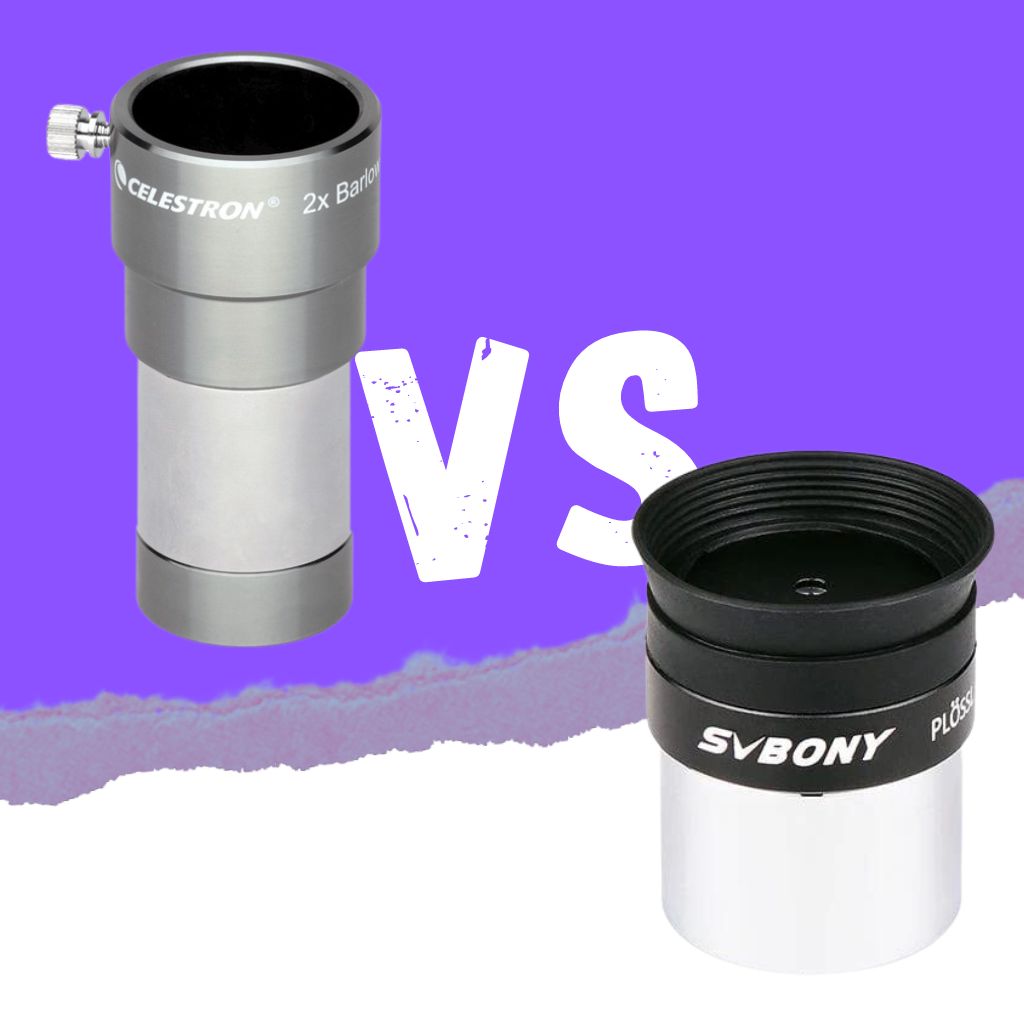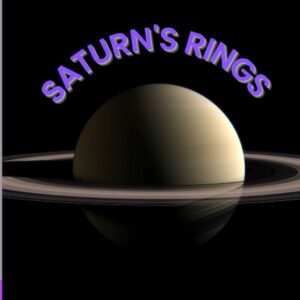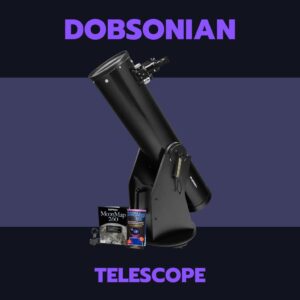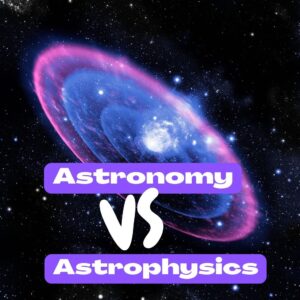This site contains affiliate links to products. I may receive a commission for purchases made through these links.
If you are looking for higher magnification with your telescope, you have two options: buy the Barlow lens or get a shorter focal length eyepiece for your collection.
But what is a better option to increase the magnification? Barlow lens or the eyepiece? They both have their advantages and disadvantages.
Barlow lenses are a better option than eyepieces if you want higher magnification. They maintain the eyepiece’s eye relief; you can use them with any telescope or eyepiece you already have.
If you use an eyepiece with a shorter focal length to increase the magnification, you get shorter eye relief and only one magnification.
Opting for a high-quality Barlow lens is also cost-effective to get more magnification options from your current eyepieces. It will effectively double or triple the eyepiece collection you have.
Let’s take a closer look at why the Barlow lens is better by explaining the basic differences between the Barlow lens and the eyepiece. But first, we need to understand how the magnification is calculated when using the telescope with a Barlow lens and eyepieces.
How to calculate the magnification of a telescope?
It is straightforward to calculate the magnification of any telescope if you know all the parameters.
These parameters are the telescope’s focal length and the eyepiece’s length. Divide the telescope’s focal length by the eyepiece’s focal length.
Let’s say you have a telescope with a focal length of 1000mm, and it comes with two eyepieces: a 20mm eyepiece and a 10mm eyepiece. You will get only two magnifications in this example, 50x magnification with a 20mm eyepiece and 100x magnification with a 10mm eyepiece.
If you need less or more magnification options with the telescope, consider expanding the eyepiece collection or buying a Barlow lens.
What is an eyepiece in a telescope setup?
I hope you already know what an eyepiece is, but just in case, let me clarify it.
The eyepiece or ocular is an optical instrument attached to the telescope’s focuser. Without the eyepiece, you can’t use a telescope (you can if you use a camera, but that’s a different topic).
A Barlow lens is not an eyepiece; you still need one if you are using the Barlow lens in the focuser.
Telescope eyepieces come in different focal lenses and sizes. There are also many types of eyepieces you can choose from. The most common eyepiece design is the Plossl eyepiece. Plossl eyepieces usually come with the telescope in the box.
Eyepieces with different focal lengths will give you different magnifications. By changing the eyepiece in the focuser, you are also changing the telescope’s magnification.
A shorter focal length will provide more magnification, and a longer one will provide less.
You can also get a zoom eyepiece. This eyepiece will provide a zoom feature like a camera lens. But as with all special accessories for a telescope, it is quite an expensive toy.
What is eye relief of the eyepiece?
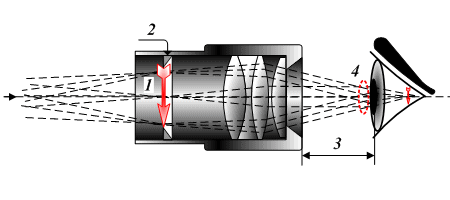
1 Real image 2 Field diaphragm 3 Eye relief
4 Exit pupil
Eye relief is the distance in millimeters between your eye and the eyepiece glass, where you can see the eyepiece’s full field of view.
Why is this important?
If you have an eyepiece with very short eye relief under 10mm, it can not be pleasant to observe it. Short focal length eyepieces tend to have very short eye relief.
So if you want higher magnification, you must use a short eyepiece with short eye relief. This is also a big problem if you wear glasses.
It is not an issue for some people, and there are high quality but expensive short eyepieces with decent eye relief.
You may also like: Best Telescope Eyepieces for Viewing Planets
What is the Barlow lens, and how does it work?
A Barlow lens is a must-have optical instrument that should be in every amateur astronomer’s inventory. A Barlow lens is purely made to increase the magnification of the telescope.
Barlow lenses have different magnification multipliers. The most common are 2x, 3x, and 5x. These numbers tell you how much Barlow will increase the telescope’s focal length.
Remember the magnification formula in our example with a 1000mm focal length telescope? This is where the magnification comes from. It does not affect the eyepiece’s focal length, only the telescope’s.
Now do the calculations again with those two eyepieces, 20mm and 10mm. Let’s say we have 2x Barlow.
You will get two additional magnifications when you use this Barlow with that telescope and eyepieces.
20mm eyepiece + 2x Barlow = 100x magnification
10mm eyepiece + 2x Barlow = 200x magnification
The telescope’s focal length doubled (from 1000mm to 2000mm), hence the double magnification with the same eyepieces. Now you have 4 eyepieces and 4 magnifications using one Barlow lens.
Another advantage here is that you can use an eyepiece with a longer focal length and comfortable eye relief to get the same magnification as with shorter ones with short eye relief without the Barlow lens.
That’s why buying one Barlow lens is better than buying more eyepieces. It is a much cheaper solution if you want more magnifications.
You may also like: Barlow Lenses: Definition, Benefits, and How to Use Them
What is the difference between a Barlow lens and an eyepiece?

A Barlow lens serves to increase magnification by increasing focal length. On the other hand, an eyepiece is to adjust the magnification by changing the lens-to-eye distance. Both are economical and practical in their ways.
Some more differences between the two are discussed below.
A major difference between the Barlow lens and an eyepiece is how both are constructed. A Barlow lens is a single or double lens adjusted between the telescope’s primary mirror and eyepiece.
For astrophotography, the Barlow lens is placed between the camera and the focuser tube. Contrary to this, an eyepiece is a single-lens or multi-lens assembly inserted into the telescope’s focuser.
Moreover, an eyepiece does not allow as many magnifications as a Barlow lens. This makes the latter a better choice in terms of cost efficiency.
A Barlow lens is also convenient as it is space-saving, and you will not need to carry dozens of eyepieces into the field. Instead, you can grab two or three eyepieces with a couple of Barlow lenses, and you are good to go!
Pros and cons of using eyepieces
Like all other scientific apparatus, eyepieces are accompanied by some pros and cons.
The pros of an eyepiece include the magnification of an image, making it easier to see details and generate results based on them. On the other hand, the cons of an eyepiece include a narrower field of view because of high magnification.
Also, in some cases, the images’ aberrations and distortions are caused by low-quality eyepieces.
There are also some other pros and cons which require a detailed explanation.
Pros of using eyepieces
Eyepieces allow the best quality light transmission, making the images easy to examine and interpret.
Not only that, but they also have versatility and variety as they can be easily changed to improve the magnification level or the field of view.
Another advantage of using an eyepiece is that this optical instrument can be customized according to the user’s preference. So according to the demand of your work, you can switch to a low-magnification or high-magnification eyepiece and achieve perfection.
Cons of using eyepieces
The most prevalent disadvantage of an eyepiece is its price. Good quality eyepieces are usually expensive and difficult to afford for beginners and hobbyists. Not only that, but eyepieces also require maintenance.
For them to work perfectly, you must ensure they remain free of dust and debris. If the cleanliness of an eyepiece is not maintained, it may affect the quality of the image.
Pros and cons of using the Barlow lens
The Barlow lens also has advantages as well as disadvantages.
A dominant advantage of using a Barlow lens is the price factor. By choosing this lens, you will free yourself from the strain of purchasing additional eyepieces to achieve higher magnification. The cons of the Barlow lens include a lower image quality and a smaller field of view.
This is why it becomes harder to track and locate objects using this apparatus.
Here are some other pros and cons of using the Barlow lens.
Pros of using the Barlow lens
If you want additional eye relief, Barlow lenses are the best choice. So, if you wear glasses or have difficulty focusing, you can get yourself a Barlow lens.
If you are interested, here’s a great Barlow lens, the Celestron Omni 2X.
The comfortable viewing distance of these lenses will make it convenient for you to focus on objects for an extended period.
Cons of using the Barlow lens
However, despite the advantages, this lens also has some serious cons. For instance, not all telescopes and eyepieces are pairable with Barlow lenses. If a Barlow lens fails to work well with a certain eyepiece, it can result in distorted images.
Additionally, some telescopes will not achieve focus with these lenses due to an extended focal length.
Barlow lens vs eyepiece astrophotography

Both Barlow lenses and eyepieces are super useful tools for astrophotography. However, both have different strengths and weaknesses.
Barlow lenses are ideal for achieving high-magnification images of the planets and the moon. On the other hand, eyepieces are a better choice if you require wide-angle imaging of deep-sky objects.
Thus, both have an important role in astrophotography.
Let’s discuss the role of both in detail. While Barlow lenses can easily double or triple the magnification of an eyepiece, eyepieces allow viewing of galaxies, nebulae, and star structures.
Additionally, eyepieces allow one to avoid chromatic aberrations and are less prone to such problems than Barlow lenses.
Before you choose between the two, it is important to consider your goals and the nature of the project that you are working on. The choice you make must be able to generate optimum results while being cost-efficient.
Not only that, but you also have to keep in view the camera and telescope that you are using before deciding between the two accessories.
Which one is better for your telescope setup?
If you are looking for higher magnification without spending too much money on additional eyepieces, the Barlow lens is the best choice for your telescope setup. It will help you achieve a range of magnifications most conveniently.
Barlow lenses increase the focal length of a device. They have varying multiplier options like 2x, 3x, 5x, etc. The different multipliers indicate the increase in focal length. However, the productivity of a Barlow lens also depends upon the eyepiece you are using.
The key is to use a Barlow lens with a multiplier to fill the magnification gaps between your eyepieces.
However, while buying a Barlow lens with a certain magnification, you must remember that atmospheric conditions limit magnification. That is why you cannot achieve high magnification beyond a certain limit.
The magnification limit of your Barlow lens is termed the “highest useful magnification.” The physical size of your Barlow lens will depend on the size of the focuser and the eyepieces you use.
Which one is the most affordable choice?
The cost efficiency of a Barlow lens and an eyepiece depends upon the nature of your use. If you want to invest once in a single accessory that will provide a range of options, the Barlow lens is ideal.
On the other hand, for people who are willing to buy multiple low-priced magnification options, an eyepiece can be a more reasonable choice. However, some eyepieces can cost much more than a Barlow lens.
Most people, especially beginners, choose Barlow lenses over eyepieces due to the variety of options that these lenses come with.
Additionally, frequently spending money to buy eyepieces with different magnification powers can be very troublesome for those who are still in the process of learning.
So for high magnifications, longer eye relief, and minimum cost, you can use a Barlow.
Is it worth getting a Barlow Lens?
The Barlow lens can be perfect if you want high-magnification views of the solar system components. They are also the best choice to resolve double and tight star clusters. In such cases, it is worth using a Barlow lens.
However, suppose you are looking forward to observing deep-sky objects. In that case, the generated images will be dimmer as the magnification increases.
Moreover, avoid buying cheap plastic Barlow lenses. Invest in good quality Barlow lenses, which are not expensive.
The “Less glass is better” myth
“Less glass is better” was true some years ago or when using very old accessories for the telescope. It means that if you incorporate more glass elements in the light train of your telescope setup, you will lose light and the quality of the image.
Using a Barlow lens in the focuser with the eyepiece is more glass in the light train. But modern optics have come a long way; nowadays, more glass sometimes results in a better image.
You will be losing some light; of course, you can’t cheat physics, but it isn’t very important, and you won’t notice it with the naked eye.
Buying a Barlow lens with more optical elements inside is also crucial. Low-quality Barlow lenses using only one optical element will destroy the quality of the image. The higher end of the Barlow lens is Powermate with 4 or more optical elements.
You may also like: Powermate vs. Barlow lens
Best Barlow lenses for your telescope
Before buying a Barlow lens, the main thing that you need to consider is the magnification factor. These lenses come with different specifications and designs. You can make the best decision by considering the magnification factor and the purpose of your use.
Some best quality Barlow lenses that you can go for include:
- Celestron Luminous 2” 2.5X Barlow Lens
- Tele Vue 3X Barlow
The best Barlow lens for you is the one that fits your needs and budget perfectly.
Final verdict: Barlow Lens vs. Eyepiece
What is my conclusion on Barlow Lens vs. Eyepiece for you? It depends. It is up to your personal preference and the setup you are using. Some amateur astronomers would argue with me for sure that using only the eyepiece is better than using a Barlow lens.
But from my experience, the Barlow lens is the best option for a beginner to squeeze more magnification from the telescope. I have collected many Barlow lenses over the years and still use them.
As discussed, different types of Barlow lenses come with different qualities and specifications.
Don’t forget to subscribe to our newsletter where you’ll find the latest cosmic discoveries, expert stargazing tips, and exclusive subscriber deals. Embark on your cosmic journey if you haven’t already!
You may also like:

